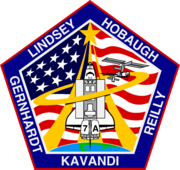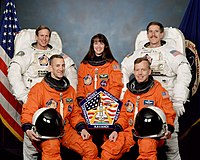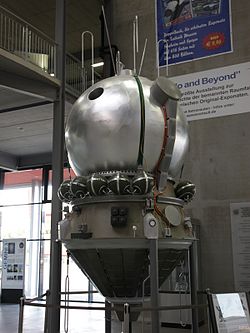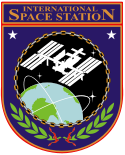STS-104
| STS-104 | |||||
 | |||||
| Uppdrag | 105 | ||||
|---|---|---|---|---|---|
| Rymdfärja | Atlantis (24)[1] | ||||
| NSSDC-ID | 2001-028A[2] | ||||
| Färdens tid | 12 dagar, 18 timmar, 36 minuter, 39 sekunder | ||||
| Uppskjutning | |||||
| Startplats | Startplatta 39B vid Kennedy Space Center i Florida | ||||
| Start | 12 juli 2001, 09:04 UTC | ||||
| Landning | |||||
| Landningsplats | KSC | ||||
| Landning | 24 juli 2001, 03:38 UTC | ||||
| Omloppsbana | |||||
| Varv | 200 st[3] | ||||
| Banlutning | 51,6° | ||||
| Sträcka | 8,500 miljoner km | ||||
| Rymdpromenad | |||||
| Antal | 3 st | ||||
| Total tid | 16 timmar, 30 minuter | ||||
| Dockning | |||||
| Rymdstation | ISS | ||||
| Dockning | 14 juli 2001, 03:08 UTC | ||||
| Dockningsport | PMA-2 (Destiny, fram) | ||||
| Urdockning | 22 juli 2001, 04:54 UTC | ||||
| Tid dockad | 8 dagar, 1 time, 46 minuter | ||||
| Besättning | |||||
| Befälhavare | Steven W. Lindsey (3) | ||||
| Pilot | Charles O. Hobaugh (1) | ||||
| Uppdragsspecialister | Michael L. Gernhardt (4) James F. Reilly (2) Janet L. Kavandi (3) | ||||
 | |||||
| Kronologi Rymdfärjeprogrammet | |||||
| |||||
STS-104 var en flygning i USA:s rymdfärjeprogram till Internationella rymdstationen ISS, flygningen genomfördes med rymdfärjan Atlantis. Den sköts upp från Pad 39B vid Kennedy Space Center i Florida den 12 juli 2001. Efter nästan tretton dagar i omloppsbana runt jorden återinträdde rymdfärjan i jordens atmosfär och landade vid Kennedy Space Center.
Flygningens huvudmål var att leverera den amerikanska luftslussmodulen Quest till stationen. Atlantis sköts upp den 12 juli 2001 och dockade med stationen den 14 juli.
Väckningar
Under Geminiprogrammet började NASA spela musik för besättningar och sedan Apollo 15 har man varje "morgon" väckt besättningen med ett musikstycke, särskilt utvalt antingen för en enskild astronaut eller för de förhållanden som råder.
| Dag | Låt | Artist/Kompositör |
|---|---|---|
| 2 | "Wallace Courts Murron" från Braveheart | |
| 3 | "God of Wonders" | Caedmons Call |
| 4 | "Space Cowboy" | 'N Sync |
| 5 | "No Woman, No Cry" | Bob Marley |
| 6 | "Nobody Does it Better" från Älskade spion | Carly Simon |
| 7 | "Happy Birthday, Darling" | Conway Twitty |
| 8 | "All I Wanna Do" | Sheryl Crow |
| 9 | "A Time to Dance" | Space Center Intermediate School Symphonic Band |
| 10 | "I Could Write a Book" från When Harry Met Sally | Harry Connick Jr. |
| 11 | "Who Let the Dogs Out" | The Baha Boys |
| 12 | "Orinoco Flow" | Enya |
| 13 | "Honey, I'm Home" | Shania Twain |
| 14 | "Hold Back the Rain" | Duran Duran |
Se även
Referenser
- ^ NASA Space Shuttle Launch Archive Arkiverad 10 augusti 2016 hämtat från the Wayback Machine., läst 28 juli 2016.
- ^ ”NASA Space Science Data Coordinated Archive” (på engelska). NASA. https://nssdc.gsfc.nasa.gov/nmc/spacecraft/display.action?id=2001-028A. Läst 22 mars 2020.
- ^ Manned Astronautics - Figures & Facts Arkiverad 16 augusti 2016 hämtat från the Wayback Machine., läst 28 juli 2016.
Externa länkar
 Wikimedia Commons har media som rör STS-104.
Wikimedia Commons har media som rör STS-104.
| ||||||||
| |||||||||||||||||||||||||||||||
| ||||||||||||||||||||||||||||||||
Media som används på denna webbplats
Författare/Upphovsman: Pascal (Flickr user: pasukaru76), Licens: CC0
Vostok spacecraft replica at the Technik Museum Speyer, Germany.
The STS-105 crew patch symbolizes the exchange of the Expedition Two and Expedition Three crews aboard the International Space Station. The three gold stars near the ascending Orbiter represent the U.S. commanded Expedition Three crew as they journey into space, while the two gold stars near the descending Orbiter represent the Russian commanded Expedition Two crew and their return to Earth. The plumes of each Orbiter represent the flags of the United States and Russia and symbolize the close cooperation between the two countries. The Astronaut Office symbol, a star with three rays of light, depicts the unbroken link between Earth and the newest and brightest star on the horizon, the International Space Station (ISS). The ascending and descending Orbiters form a circle that represents both the crew rotation and the continuous presence in space aboard the ISS. The names of the four astronauts who will crew Discovery are shown along the border of the patch. The names of the Expedition Three and Expedition Two crews are shown on the chevron at the bottom of the patch. The NASA insignia design for Shuttle flights is reserved for use by the astronauts and for other official use as the NASA Administrator may authorize. Public availability has been approved only in the form of illustrations by the various news media. When and if there is any change in this policy, which we do not anticipate, it will be publicly announced.
In this illustration, a SpaceX Crew Dragon spacecraft approaches the International Space Station for docking. NASA is partnering with Boeing and SpaceX to build a new generation of human-rated spacecraft capable of taking astronauts to the station and expanding research opportunities in orbit. SpaceX's upcoming Demo-1 flight test is part of NASA’s Commercial Crew Transportation Capability contract with the goal of returning human spaceflight launch capabilities to the United States.
Backdropped by a blue and white Earth, this close-up view features the Soyuz TMA-6 spacecraft approaching the International Space Station (ISS). Onboard the spacecraft are cosmonaut Sergei K. Krikalev, Expedition 11 commander representing Russia's Federal Space Agency; astronaut John L. Phillips, NASA ISS science officer and flight engineer; and European Space Agency (ESA) astronaut Roberto Vittori of Italy. The Soyuz linked to the Pirs Docking Compartment at 9:20 p.m. (CDT) on April 16, 2005 as the two spacecraft flew over eastern Asia. The docking followed Friday’s launch from the Baikonur Cosmodrome in Kazakhstan.
These five astronauts are currently in training for the STS-104 mission, scheduled for a June 2001 liftoff. Seated with the crew insignia are astronauts Steven W. Lindsey (right), mission commander; and Charles O. Hobaugh, pilot. Standing, from left, are astronauts Michael L. Gernhardt, Janet L. Kavandi and James F. Reilly, all mission specialists.
STS104-S-001 (March 2001) --- STS-104, International Space Station (ISS) assembly mission 7A, marks the completion of the initial assembly phase of ISS. The 7A crew will install, activate, and perform the first space walk from the Joint Airlock. The Joint Airlock will enable crews to perform space walks in either United States or Russian spacesuits while recovering over 90 percent of the gases that were previously lost when airlocks were vented to the vacuum of space. This patch depicts the launch of Space Shuttle Atlantis and the successful completion of the mission objectives as signified by the view of the ISS with the airlock installed. The astronaut symbol is displayed behind Atlantis as a tribute to the many crews that have flown before. The hard work, dedication, and teamwork of the airlock team is represented by the ISS components inside the payload bay which include the Joint Airlock and four high pressure gas tanks containing nitrogen and oxygen. In the words of a STS-104 crew spokesperson, "The stars and stripes background is symbolic of the commitment of a nation to this challenging international endeavor and to our children who represent its future." The NASA insignia design for Shuttle flights is reserved for use by the astronauts and for other official use as the NASA Administrator may authorize. Public availability has been approved only in the form of illustrations by the various news media. When and if there is any change in this policy, which is not anticipated, it will be publicly announced.
Rotated and color enhanced version of original (ISS013-E-48788 (6 July 2006) --- The Space Shuttle Discovery approaches the International Space Station for docking but before the link-up occurred, the orbiter went through a series of inspection photos by station crew to inspect the vehicle for any damage to its Thermal Protection System. This was known as the Rendezvous Pitch Maneuver and was implemented after the Columbia Disaster in 2003. The Leonardo Multipurpose Logistics Module can be seen in the shuttle's cargo bay. Discovery docked at the station's Pressurized Mating Adapter 2 at 9:52 a.m. CDT, July 6, 2006.)
STS-100 Patch













